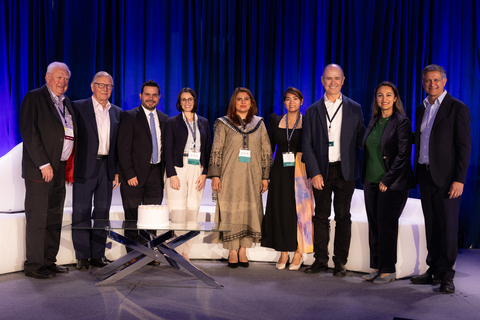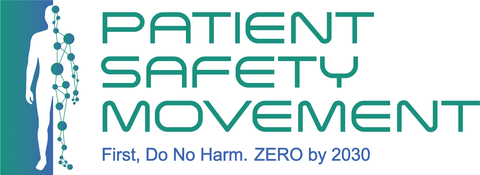Day 2 of 11th Annual World Patient Safety, Science & Technology Summit Highlights Importance of Collaboration and Advanced Technologies
Day 2 of 11th Annual World Patient Safety, Science & Technology Summit Highlights Importance of Collaboration and Advanced Technologies
The Global Interprofessional Patient Safety Fellowship at the 2024 PSMF Summit. From left to right: Dr. Michael A.E. Ramsay, Chief Executive Officer of PSMF; Dr. Mike Durkin, Chair of PSMF and Senior Advisor on Patient Safety Policy and Leadership, Institute of Global Health Innovation, Imperial College London; Luis Torres Torija Arguelles, MD, MBA, Ambassador of PSMF, Mexico; Natalia Camargo, RN and healthcare quality management specialist, Sao Paulo, Brazil; Afifa Munawar, BScN, MSPH, Technical Officer, Quality Patient Safety and Hospital Sector of WHO Country Office Pakistan; Angeli Merci Mejia Porto, MD, FPOGS, Obstetrician and Gynecologist at Region II Trauma and Medical Center, Philippines; Dr. Peter Lachman, Lead Faculty Quality Improvement, Royal College of Physicians of Ireland; Sanaz Massoumi, MS, PhD, Chief Operating Officer of PSMF; Joe Kiani, Founder of the Patient Safety Movement Foundation. (Photo: Business Wire)
IRVINE, Calif.--(BUSINESS WIRE)--The second day of the 11th Annual World Patient Safety, Science & Technology Summit, presented by the Patient Safety Movement Foundation (PSMF) on the UC Irvine campus, underscored the theme of collaboration as essential in creating a future in which no patients are harmed by preventable medical errors and technologies continue to evolve at an accelerated pace to advance patient care.
“The future of healthcare is rapidly changing around the world,” said PSMF Founder Joe Kiani. “We need all hands on deck, including patients and their families. I hope everyone walks away from this year’s Summit with clarity on how they will contribute to reaching zero preventable medical harm. The most important lesson is that we don’t need to do it alone. We need a network where we can all be there for each other and share both the challenges and solutions. If you haven’t already done so, please join our Patient Safety Leadership Association.”
“Today’s presentations at the World Patient Safety, Science & Technology Summit showed that there is a real need for patients and their families to work together with doctors, nurses, pharmacists, and therapists to challenge the current model and demand change so that health systems consistently deliver open and transparent access to the level of avoidable harm,” stated Dr. Mike Durkin, Chair of the PSMF Board of Directors and the former National Director of Patient Safety for the UK’s National Health Service. “They should also go further to challenge their political representatives to deliver health systems to provide equitable and inclusive delivery to every member of their population.”
Dr. Sanaz Massoumi, PSMF’s Chief Operating Officer, spoke next on forging the future of patient safety, stating, “Fostering a culture of safety is a holistic approach that engages the entire system in prioritizing patient safety at the core of every decision-making process, proactively assessing and mitigating risks.”
In a video-taped message presented during the morning session, Dr. Tedros Adhanom Ghebreyesus, Director-General of the World Health Organization, alerted attendees to the challenges to patient safety posed by attacks on healthcare workers in areas of conflict, numbering more than 7,000 attacks in 21 different countries and territories resulting in over 2,200 deaths since 2018. He urged, “Health workers and health facilities must never be attacked and must be actively protected even in the most arduous conditions. We must take a united stand for the protection and safety of patients, health workers, and health facilities.”
The Rt Hon Jeremy Hunt MP, in another recorded message, told attendees how he got involved with Joe Kiani and the Patient Safety Movement Foundation and their efforts to persuade the World Health Organization to set up a World Patient Safety Day (which takes place on September 17). He remarked, “I was taken on this journey actually not by medical experts but by ordinary members of the public who’d lost loved ones in the most tragic of circumstances. That told me something needed to change.”
In the day’s first keynote, Dr. John Wyte, Chief Medical Officer at WebMD, discussed the impact of misinformation on patient safety at a time when more and more people are relying on internet searches for health-related information (one billion queries a day!), mobile apps, wearable devices, and other emergent technologies.
Representing the host venue for this year’s Summit, Dr. Michael Stamos, who serves as Dean of the UC Irvine School of Medicine, described how the UCI School of Medicine and the health center’s leadership are structured to optimally support an improved safety culture among physicians and staff and to promote better patient outcomes.
Updating attendees on the US Department of Health and Human Services’ efforts to improve patient safety, Amy Ashcraft, Deputy Regional Inspector General from the Office of Inspector General, emphasized the importance of tracking and reporting all harm incidents and data transparency. She also outlined HHS’s initiatives to protect patients through the Agency for Healthcare Research and Quality (AHRQ) and Center for Medicare and Medicaid Services (CMS).
Dr. Daniel Cole, the Executive Director for Professional Affairs at the American Board of Anesthesiology, explored the transformative impacts of emerging technologies, including remote monitoring devices, medical imaging, and healthcare data analytics, on perioperative care.
Using advanced technologies, including AI, to help protect patients and improve their care was an important theme throughout this year’s Summit. Dr. Michael Ramsay, PSMF’s Chief Executive Officer, observed, “We are at an important crossroads in the evolution of patient safety. New technologies enable us to monitor patient vitals remotely, AI can be used as a check against misdiagnosis and to predict harm events, and telehealth expands healthcare access and equity. Through our ongoing collaborative efforts and sharing data, healthcare providers in partnership with Med-Tech, government agencies, patients, and other stakeholders can protect patients in ways that were unimaginable a decade ago.”
Like the keynote presentations, panels during the Summit’s second day continued to build on the previous day’s insights and momentum. In one panel, leading patient advocates addressed the important issue of engaging patients and their family members, and Dr. Mike Durkin led another panel to discuss the state of affairs in patient safety around the world.
PATIENT SAFETY MOVEMENT FOUNDATION
In 2012, Joe Kiani founded the non-profit Patient Safety Movement Foundation to eliminate preventable medical errors in hospitals. His team worked with patient safety experts from around the world to create Actionable Evidence-Based Practices that address top challenges. Hospitals can make a formal commitment to ZERO preventable deaths, and healthcare technology companies are asked to sign the Open Data Pledge to share their data so that predictive algorithms can be developed to identify errors before they become fatal. The PSMF was established through the support of the Masimo Foundation for Ethics, Innovation, and Competition in Healthcare.
Contacts
Patient Safety Movement Foundation
Irene Mulonni, irene@mulonni.com | (858) 859-7001

